20.1: Comparing Economies
20.1.1: Economic Growth as a Measuring Stick
Economic growth is measured as the increase in real gross domestic product (GDP) in the long-run, through higher resources or productivity.
Learning Objective
Examine the components that cause economic growth
Key Points
- Economic growth could also be described as an outward shift in the production-possibility frontier, allowing for the generation of a higher quantity of goods.
- While measuring real GDP is useful in some ways, and considered a standard measure of economic growth, there is a great deal more complexity than is being captured (both quantitatively and qualitatively).
- Classic growth theory uses the production function to measure economic growth, which ultimately implies that economic growth constantly compounds.
- Growth accounting came into popularity after the classic model, identifying the crucial role of technology in economic growth.
- A more educated workforce will result in increases in real output, as will advances in technology and innovation.
Key Terms
- inflation
-
The rise in the general level of prices of goods and services in an economy over a period of time.
- gross domestic product
-
A measure of the economic production of a particular territory in financial capital terms over a specific time period.
Economic growth can be defined as the increase in real gross domestic product (GDP) in the long-run, or as increased productivity or via an increase in the natural resources (inputs) that create output. It is important to note that real GDP adjusts for inflation, rather than looking at output in nominal dollars. Economic growth could also be described as an outward shift in the production-possibility frontier, allowing for the production of a higher quantity of goods (see ).

Production-Possibility Frontier
This outward shift in the Production-Possibility frontier is indicative of economic growth within the economy it represents.
Standard Measures of Economic Growth
Measuring economic growth is reasonably straight-forward, primarily focusing on either increases in productivity or increases in the available production inputs in a given system. This increase in productivity is converted into a relative percent based upon previous years, and expressed as a growth or decline. For example, if a given economy is producing $1,000,000 in 1900 and 1,050,000 in 1901, the economic growth rate (or GDP growth) will be expressed as 5%. If inflation is calculated to be 3% between 1900 and 1901, real economic growth will equate to 2%.
Alternative Economic Growth Models
While measuring real GDP is useful in some ways, and considered a standard measure of economic growth, there is a great deal more complexity than is being captured (both quantitatively and qualitatively). An outline of the perspectives of economic growth over time include:
- Classical Growth Theory: Dating back to Adam Smith and the foundation of capitalism, classical growth theory uses the production function to measure economic growth.
, where Y, K, L and N represent output, capital, labor and land respectively. In this model, the overall growth of an economy will compound exponentially and capture economies of scale, implying that economic expansion via consistent growth is a reasonable proposition. - Growth Accounting: Growth accounting came into popularity after the classical model, identifying the crucial role of technology in economic growth. Using the same classical growth equation, this method of measuring economic growth replaces the ‘land’ variable with ‘technology’ (technology including all of the contextual components that enable growth). In this scenario, technological leaps and bounds can be captured in the overall growth model.
- Salter Cycle: Economic growth is ultimately enabled by increases in productivity, and thus reductions in the required inputs to achieve each subsequent output per unit. As a result, an economy will continuously decrease price and thus increase demand, minimizing marginal utility over time and saturating markets.
- Endogenous Growth Model: This model takes into account technology, as in the growth accounting system discussed above, alongside increases in skills and intellectual capital. A more educated workforce will result in increases in real output, as will advances in technology and innovation.
- Energy Growth Theory: There has been a consistent correlation between economic growth and energy increase, alongside a paradox that increased energy and resource utilization efficiency actually increases consumption of that resource (similar to the Salter Cycle concept). As a result, energy growth theory economists identify a critical role of energy and resources in measuring overall economic growth.
20.1.2: How to Compare Economies Throughout History
Economies throughout history are defined by an evolution towards common currencies, global trade, and technologies driving productivity.
Learning Objective
Describe historical trends in rates of economic growth
Key Points
- Comparing historical economies and economic trends over the course of human history is a difficult endeavor, as the comparisons are not always equal.
- Babylonians are credited with generating the first metric to measure economic value (i.e. currency) and standardizing trade through leveraging this metric.
- The creation of the first official paper currency (or banknotes) by the Tang Dynasty in China around the 9th century.
- As the 20th century dawned, real world GDP is estimated to have quadrupled as a result of the advances in industry (see, technology, and intellectual innovations.
- Modern economies have been consistently measured for growth over the past couple centuries, underlining useful economic data on overall growth between nations. To simplify these comparisons, economic growth is generally assessed as general GDP.
Key Terms
- Bartering
-
Exchange goods or services without involving money.
- evolution
-
Gradual directional change especially one leading to a more advanced or complex form; growth; development.
- economic growth
-
The increase of the economic output of a country.
Comparing historical economies and economic trends over the course of human history is a difficult endeavor, as the comparisons are not always equal. The evolution of trade and the construction of measurement systems, currencies, standards, and the accuracy of historical record present a challenge to economists evaluating economies over time. That being said, timelines have been generated that capture useful insights, and modern economic comparisons (country to country) are growing increasingly accurate. Both of these perspectives shed light as to the overall patterns of economic growth over time.
Relevant Time Periods
For the sake of this discussion, four general time frames are useful to highlight:
- Stone Age: Including the Paleolithic, Mesolithic, and Neolithic time frames (up to 3500 B.C.), economics was virtually basic trade between small, local groups. This age is particularly worthy of note due to the crucial development of bartering and specialization. Specialization refers to the fact that a small group of people performing (and specializing) in different tasks can create substantially more value than every individual learning all tasks (think of Henry Ford’s assembly line).
- Antiquity: This includes the Bronze Age and the Iron Age, antiquity spans from 3500 B.C. around 500 A.D. As the names imply, the leveraging of natural resources (such as metals) were a critical step forward for trade. During this time frame the Babylonians are credited with generating the first metric to measure economic value (i.e. currency), and standardizing trade through leveraging this metric. This is an absolutely critical component to the ultimately measurement and comparison of economies from this time period forward.
- Middle Ages: The Silk Road is a famous economic historical element of this time frame, as is the creation of the first official paper currency (or banknotes) by the Tang Dynasty in China around the 9th century. The Middle Ages stretched from 500 A.D.-1500 A.D., and eventually saw the roots of accounting and financial trade roles in society.
- Modernity: From 1500 A.D. forward, trade grew increasingly global and increasingly standardized as a result. This era is marked by the Industrial Revolution, and the exponential productivity growth inherently found in technological advancement and standardized education systems. As the 20th century dawned, real world GDP is estimated to have quadrupled as a result of the advances in industry (see ), technology and intellectual innovations. Subsequently, population expanded as well.
With these four eras in mind, it is easy to empathize with economists attempting to unveil relative economic strength in the context of capitalist evolution. The modern age provides the most consistent data in which to analyze growth.
Comparing Modern Economies
Modern economies have been consistently measured for growth over the past couple centuries, underlining useful economic data on overall growth between nations. To simplify these comparisons, economic growth is generally assessed as general GDP (or increased productivity within a nation). The figure demonstrates these comparisons between 1990 and 2006, with a few countries standing out (China in particular).
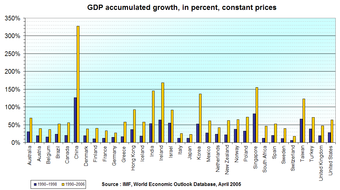
GDP Growth Across Nations
This graph underlines the important fact that economic growth is not mutually or equally distributed, resulting from a wide variety of factors with external and global systems.
Over time, countries can change significantly, and these changes must be considered in order to make accurate comparisons. Inflation, for example, changes the value of one unit of currency across time, so comparisons across time should be made using Real GDP, a GDP index, or another measure that accounts for changes in price.
There are also a number of other factors that must be taken into account such as GDP per capita, energy consumption, pollution metrics, education levels, innovation, etc. As you can imagine, it is difficult to compare countries across large time horizons, but, after controlling for as many of these effects as you can, comparisons are possible.
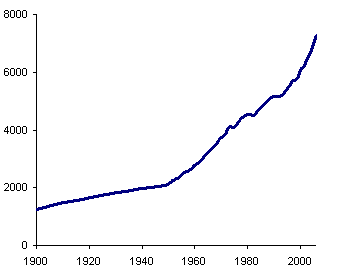
Economic Growth in the 20th Century
As a result of technological advances and increased intellectual capacity, real productivity increased by over 400% during this time frame.
20.1.3: Is Economic Growth a Good Goal?
Economic growth is typically viewed as positive, but there are mixed repercussions of increased productivity within an economic system.
Learning Objective
Identify the value of economic growth objectives.
Key Points
- The relationship between economic growth and the well-being of a society has largely been viewed as positive throughout the course of history.
- Economic growth increases consumer purchasing power and leisure time along with governmental purchasing power for societal benefits.
- The concept of uneconomic growth postulates that the costs of economic growth may outweigh the benefits, those costs being the environmental and societal repercussions.
- It is imperative that increased productivity can be created in a context in which the value can be captured in a positive and meaningful way.
- It is imperative that increased productivity can be created in a context in which the value can be captured in a positive and meaningful way.
Key Term
- Jevon’s Paradox
-
The proposition that technological progress that increases the efficiency with which a resource is used tends to increase the rate of consumption of that resource.
Throughout history, economists have typically assumed a positive relationship between economic growth (increased productivity) and the well-being of a society. It seems logical to assume that a stronger economy would create a higher standard of living. However, there is some debate surrounding the validity of this assumption. Is economic growth the appropriate objective?
Why is Growth Good?
Economic growth is the increase in the market value of the goods and services produced by an economy over time. Simply, more economic growth means that people are able to buy more of the things they like. Presumably, this translates into higher overall utility.
On a societal level, increases in GDP growth and overall productivity generates high prospective tax revenues, both on business profits and consumer purchases. Higher tax revenues will allow governments more financial flexibility to invest in social services such as education, welfare, transportation, etc.
Drawbacks to Economic Growth
There are, however, some downsides to economic growth, which are summarized in the idea of uneconomic growth. The concept of uneconomic growth postulates that the costs of economic growth – primarily environmental and social costs – may outweigh the benefits. There are a few specific observations of this that are worth noting:
- Jevon’s Paradox:Interestingly, increases in efficiency which drive increased economic growth often result in higher consumption. For example, when an economic system creates higher efficiency for generating electricity it will often increase the amount of electricity consumer in spite of that increased efficiency. This creates a culture of consumerism which is often wasteful.
- Malthusian Trap: Named after a political economist named Thomas Robert Malthus, the Malthusian trap simply states that increases in efficiency tend to result in population growth rather than wealth growth. Increased productivity within a system is only useful if it translates to an increase in per capita wealth.
- Imbalanced Distribution:Another issue is income distribution. This is what was meant by the adage that the rich get richer while the poor get poorer. It is quite common to see the rich absorb the vast majority of the value generated through increased productivity, creating a larger relative gap between the rich and the poor. In this circumstance there is limited utilitarian value to economic growth.
- Environmental Degradation: The final criticism is often the most discussed, particularly in light of the overwhelming evidence of global warming and the destructive nature of excessive consumption. It is also reasonable to consider the finite nature of natural resources (see ). Scientific modeling by environmental scientists often demonstrate significant long-term risks for the well-being of the ecosystem, posing a very real threat to the overall value in continued economic growth. Is it worth having more to consume if there is no ecosystem in which to enjoy it?
The important takeaway from this is to think carefully about the value created by economic growth. It is imperative that increased productivity can be created in a context in which the value can be captured in a positive and meaningful way.

Petroleum Consumption Over Time
This figure demonstrates the risk of over-consuming our natural resources, ultimately resulting in scarcity of necessary goods. A continued drive for economic growth could lead to overconsumption of natural resources.
20.2: Assessing Growth
20.2.1: Calculating Economic Growth
Economic growth is the increase in the market value of goods and services produced by an economy over time; the percentage rate of increase in the GDP.
Learning Objective
Calculate various measures of economic growth
Key Points
- In economics, economic growth refers to the growth of potential output. It shows how a country is developing its economy.
- The short-run variation in economic growth is called the business cycle. Economists use it to distinguish between short-run variations in economic growth and long-run economic growth.
- Long-run economic growth is measured as the percentage rate increase in the real gross domestic product.
- The GDP can be calculated using the product approach, income approach, or expenditure approach. The GDP is defined as the market value of all officially recognized final goods and services produced within a country in a given period of time.
Key Terms
- business cycle
-
A fluctuation in economic activity between growth and recession.
- gross domestic product
-
A measure of the economic production of a particular territory in financial capital terms over a specific time period.
- economic growth
-
The increase of the economic output of a country.
Economic Growth
Economic growth is defined as the increase in the market value of goods and services produced by an economy over time. It is usually measured as a percentage rate of increase in the real gross domestic product. In economics, economic growth refers to the growth of potential output. It shows how a country is developing its economy. Economic growth is directly impacted by human capital, which is the level of school or knowledge attainment in a country. The cognitive skills of a population directly impact economic growth. In general, economic growth is recorded and studied over the short-run and long-run.
Short-run Economic Growth
The business cycle refers to economy-wide fluctuations in production, trade, and economic activity over several months or years. The short-run variation in economic growth is called the business cycle. Economists use it to distinguish between short-run variations in economic growth and long-run economic growth. The cycle is made up of increases and decreases in production that occur over months and years. The changes in the business cycle are a result of fluctuations in aggregate demand .

The Business Cycle
The business cycle is used to determine the short-run variation in economic growth. Variations in the business cycle fluctuation over months and years and are attributed to fluctuations in aggregate demand.
Long-run Economic Growth
Long-run economic growth is measured as the percentage rate increase in the real gross domestic product. The GDP is defined as the market value of all officially recognized final goods and services produced within a country in a given period of time. There are three approaches used to determine the GDP:
- Product (output) approach: adds together the outputs of every class of enterprise to provide the total.
- Income approach: calculates the sum of all the producers’ incomes.
- Expenditure approach: the value of the total product must be equal to the people’s total expenditures.
In principle, all of the approaches should yield the same result for the GDP of a country.
For example, the equation for the expenditure approach is: GDP = C + I + G + (X – M).
Written out in full, the gross domestic product (GDP) equals private consumption (C) plus, gross investment (I), government spending (G), and the exports minus the imports (X – M).
For economic purposes, the economic growth is calculated and compared to the population, also know as per capita income (indicator of a country’s standard of living). When the per capita income increases it is called intensive growth. When the GDP growth is only caused by increases in population or territory it is called extensive growth.
20.2.2: Growth in the United States
The economy in the United States is the world’s largest single national economy; 2013 GDP estimation was $16.6 trillion.
Learning Objective
Describe historical growth in the US
Key Points
- Currently, the U.S. has a mixed economy, a stable GDP growth rate, moderate unemployment, and high levels of research and capital investment.
- Throughout its history, the U.S. has experienced economic growth in varying degrees. Time periods can be broken down by century and by decades.
- The U.S. economy experienced its most extensive growth from 1961 to 1969.
Key Terms
- financial crisis
-
A period of serious economic slowdown characterized by devaluing of financial institutions often due to reckless and unsustainable money lending.
- recession
-
A period of reduced economic activity
- economic growth
-
The increase of the economic output of a country.
Economic Growth
Economic growth is defined as the increase in the market value of the goods and services produced by an economy over time. It is measured as the percentage rate of increase in the real gross domestic product (GDP). To determine economic growth, the GDP is compared to the population, also know as the per capita income. When the per capita income increases it is called intensive growth . When the GDP growth is only cause by an increase in population or territory it is called extensive growth.
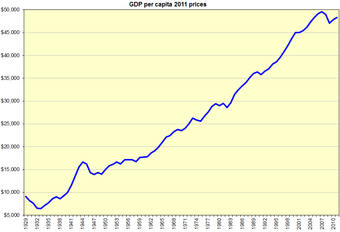
U.S. GDP per capita (1929-2010)
This graph shows the GDP per capita in the United States from 1929 to 2010. The GDP per capita is the ratio of the GDP to the population. This graph shows the intensive growth of the United States during this time period.
U.S. Economy
The economy in the United States is the world’s largest single national economy. In 2013, the estimated GDP was $16.6 trillion, which is a quarter of the nominal global GDP. Currently, the U.S. has a mixed economy, a stable GDP growth rate, moderate unemployment, and high levels of research and capital investment.
U.S. Economic Growth
Throughout its history, the U.S. has experienced economic growth in varying degrees. Various historical time periods illustrate the rate of growth:
- Prior to industrialization: technological progress caused an increase in population, which was kept in check by food supply and other resources. The per capita income was limited.
- Industrial Revolution: a period of rapid economic growth. Despite the initial excess of population growth, the growth did eventually slow down; a condition called demographic transition. During the first Industrial Revolution mechanization was introduced. During the second Industrial Revolution, wind and water power replaced human and animal labor. This increased the level of production.
- 20th century growth: most economic growth in the 20th century was due to reduced inputs of labor, materials, energy, and land per unit of economic output. The growth was more balanced because more inputs were used due to the growth of output. Also, this time period experienced the production of new goods and services through innovations.
- 1920s: during this time period there was overproduction which was one cause of the Great Depression in the 1930s. Economic growth resumed following the depression and was aided by the demand for new goods and services (telephones, radios, televisions, etc. ).
- 1940 to 1970: the U.S. economy grew by an average of 3.8% and the real median household income surged 74% (2.1% a year).
- 1960s: the U.S. economy experienced its most extensive periods of economic growth from 1961 to 1969 with an expansion of 53% (5.1% a year).
- 1970s: the economy experienced slower growth after 1973. The average growth was 2.7%, there were stagnant living conditions, and household incomes increased by 10% (0.3% annually). The 1973 oil crisis caused the GDP to fall 3.7%. The GDP fell again in late 1973 to 1975 (3.1%).
- 1980s: the U.S. share of the world GDP peaked in 1985 with 23.78% of global GDP. There was a recession from 1981 to 1982 when the GDP dropped by 2.9% .
- 1990s: there was a mild recession in 1990 to 1991 when the output fell by 1.3%.
- 2000s: one of the worst recessions in recent decades occurred in 2008 when the GDP fell by 5.% in one year. The 2008 financial crisis was caused by a derivatives market, the subprime mortgage crisis, and a declining dollar value.
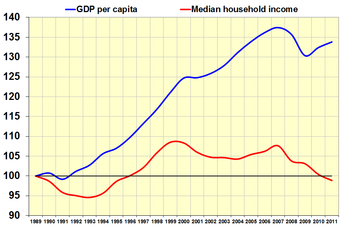
U.S. GDP vs. Household Income (1989-2011)
This graph shows the relationship of the GDP in the United States to the household income. This period from 1989 to 2011 was hit by a number of recessions.
20.2.3: Growth in the Rest of the World
On a global scale, economic growth is the sum of the growth of individual countries to give a worldwide total.
Learning Objective
Describe historical growth in developing and developed countries
Key Points
- Economic growth and global impact varies by country based on the individual economy, the development of the country, accumulation of human and physical capital, and level of productivity.
- Due to the vast number of countries globally, the world economy is usually determined in monetary terms, even in cases where no efficient market is available to evaluate goods and services.
- From 1990 to 2000 the U.S. dominated in expansion. From 2006 to 2006, China’s expansion moved closer to that of the United States. China led in expansion in 2007.
- The global credit crisis started in 2008 and expanded in 2009. By 2010, the U.S. had experienced some economic recovery while the global economic growth had lost momentum.
- From 2010 to 2018, China is expected to led in expansion. The global economic output is projected to expand.
Key Terms
- economic growth
-
The increase of the economic output of a country.
- purchasing power
-
The amount of goods and services that can be bought with a unit of currency or by consumers.
- gross domestic product
-
A measure of the economic production of a particular territory in financial capital terms over a specific time period.
Economic Growth
Economic growth is the increase in the market value of goods and services produced by an economy over a period of time. It is measured as the percentage rate increase in the real gross domestic product (GDP). On a global scale, economic growth is the sum of the growth of individual countries to give a worldwide total. Economic growth and global impact varies by country based on the individual economy, the development of the country, accumulation of human and physical capital, and level of productivity .
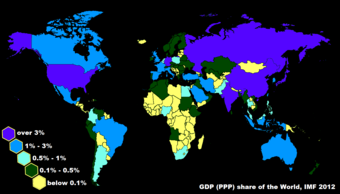
Share of World GDP
This image shows the share of GDP worldwide. The economic growth and global impact that each country has is influenced by the individual economy, the development of the country, accumulation of human and physical capital, and level of productivity.
Global Economic Growth
Due to the vast number of countries globally, the world economy is usually determined in monetary terms, even in cases where no efficient market is available to evaluate goods and services. The market valuations are translated into a single monetary unit using the idea of purchasing power. Analyzing economic growth in prominent countries provides an overview of global economic growth .
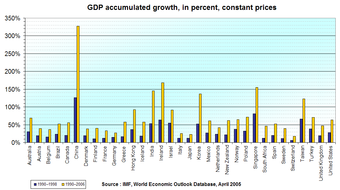
Change in GDP
This graph shows the change in GDP for countries around the world for 1900 to 1999 and 1999 to 2006. The GDP for each individual country is used to determine the global economic growth.
- 1980 to 1990: during this time period the economic output of 112 countries expanded while the output of 34 countries contracted. The purchasing power expanded for 145 markets and contracted for two. The five largest contributors to global output contraction were Argentina, Saudi Arabia, Nigeria, Venezuela, and Vietnam.
- 1990 to 2000: the United States dominated expansion during these years. The economic output expanded for 122 countries and contracted for 29. The purchasing power increased for 148 markets and contracted for three. The five largest contributors to global output contraction were Italy, Finland, Bulgaria, Algeria, and the Demographic Republic of Congo.
- 2000 to 2006: Expansion in China moved the country closer to the United States. The economic output for 176 countries expanded and four contracted. The five largest contributors to the expansion were the United States, China, Germany, the United Kingdom, and France. The purchasing power increased for 180 markets. The largest global output contributors were the United States, China, India, Japan, and Russia. From 2000 to 2010 these was a rise in developing and emerging economies.
- 2007: The nominal GDP expanded in 183 countries. The largest contributors were China, the U.S., Germany, and the United Kingdom.
- 2008: the credit crisis started. Economic output expanded in 171 countries, but 11 countries experienced output contractions. The United Kingdom accounted for half the global contraction while South Korea accounted for two-fifths. The crisis impacted most countries, but it was not deep enough to reverse growth.
- 2009: the credit crisis spread. The economic output of 127 countries contracted. The United Kingdom was impacted the most, followed by Russia and Germany. 56 countries experienced expansion of economic output, including China, Japan, and Indonesia. The purchasing power contracted for 79 markets. The U.S. was the largest victim and accounted for 18%, followed by Japan and Russia. 104 markets expanded purchasing power including China, India, and Indonesia.
- 2010: the economic output expanded for 148 countries and contracted for 35. The purchasing power increased for 169 markets and contracted for 14. It was noted that banks faced a “wall” of maturing debt. The U.S. experienced economic recovery, but the global economic growth lost momentum.
- 2011 to 2012: in 2011 it was projected that global growth would drop 4% followed by another 3.5% drop in 2012.
- 2010 to 2018: it is projected that China will lead economic growth during this period. The global economic output is expected to expand by $32.9 trillion.
Power of Annual Growth
Over long periods of time, small rates of growth have large economic effects. For example, the United Kingdom experienced a 1.97% average annual increase in its GDP from 1830 to 2008. The growth rate averaged 1.97% over 178 years and resulted in a 32-fold increase in the GDP by 2008. The GDP in 1830 was £41,373. It grew to £1,330,088 by 2008.
A growth rate of 2.5% a year leads to a doubling of the GDP within 29 years. A growth rate of 8% a year leads to a doubling of the GDP in 10 years. As a result, small differences in economic growth rates between countries can produced very different standards of living for the populations if the small growth rate continues for many years.
20.2.4: Catch-Up: Possible, but not Certain
Developing countries can catch up to developed countries by achieving growing faster, which is determined by a wide number of country-specific factors.
Learning Objective
Describe different factors that affect the growth rate of developing economies
Key Points
- Every country is unique based on population, technology, government, wealth, ect. Economic growth can be compared between countries, although no two countries are the same.
- Factors that influence economic growth include: growth of productivity, demographics, labor force participation, human capital, inequality, trade, quality of life, and employment rate.
- The economic growth of any country takes time to develop. Some countries have much larger, stronger, and more developed economies than other countries.
- It is possible, but not certain that smaller, underdeveloped economies can experience economic growth and catch-up to more prominent economies.
Key Terms
- economic growth
-
The increase of the economic output of a country.
- gross domestic product
-
A measure of the economic production of a particular territory in financial capital terms over a specific time period.
- demographics
-
The characteristics of human populations for purposes of social studies.
Economic Growth
Economic growth is defined as the increase in the market value of the goods and services produced by an economy over time. In order to assess economic growth it must be measured. It is the percentage rate of increase in real gross domestic product (GDP). When looking at the long-term economic growth of a country, it is important to analyze the ratio of the GDP to the population (GDP per capita).
For a developing country to catch up to a developed country, it must not only grow, but grow faster than the developed country. It is possible for such accelerated growth to occur, but there are many country-specific factors that affect a country’s ability to catch up to developed countries.
Factors that Impact Economic Growth
There are specific factors that have a direct impact on the economic growth of a country. Every country is unique based on population, technology, government, wealth, etc. Economic growth can be compared between countries, although no two countries are the same. Some of the factors that impact economic growth include:
- Growth of productivity: the growth of productivity is the ratio of economic output to input (capital, labor, energy, materials, and services). When productivity increases the cost of goods decreases causing an increase in the per capita GDP. Lower prices create an increase in higher aggregate demand. The growth of productivity is the driving force behind economic growth.
- Demographics: demographics change the employment to population ratio as well as the labor force participation rate. The age structure of the population affects the labor force participation rate. For example, when women entered the workforce in the U.S. it contributed to economic growth, as did the entrance of the baby boomers into the workforce.
- Labor force participation: the rate of labor force participation impacts economic growth. It is the number of people working in the labor force. When manufacturing increased, it created a higher productivity rate, but lowered the labor force participation, prices fell, and employment shrank.
- Human capital: human capital is referred to as the skills of the population. Education is a commonly used measurement for human capital. Human capital increases the society’s skill which increases economic growth.
- Inequality: inequality in wealth and income has a negative impact on economic growth. Inequality results in high and persistent unemployment. This has a negative effect on long-run economic growth.
- Trade: international trade represents a significant part of GDP for most countries. It is the exchange of goods and services across national borders.
- Quality of life: happiness has been shown to increase with a higher GDP per capita. Quality of life is a direct result of economic growth. When poverty is alleviated and society has access to what it needs, the quality of life increases. Consistent quality of life leads to continued economic growth.
- Employment rate: in order for the employment rate to have a positive impact on economic growth there must also be increases in productivity. If employment increases, but productivity does not, then there is a higher number of working poor.
Economic Growth in Developing Countries
The economic growth of any country takes time to develop. Some countries have much larger, stronger, and more developed economies than other countries . The study of the economic aspects of development in low-income countries is called development economics. It focuses on methods for promoting economic development. All of the factors listed previously impact economic growth – most of them positively. It is possible, but not certain that smaller, underdeveloped economies can experience economic growth and catch-up to more prominent economies.
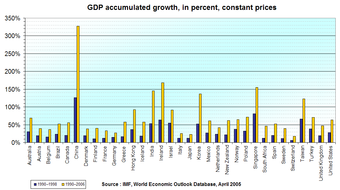
Change in GDP
This graph shows the change in GDP for various countries for the periods of 1990 to 1998 and 1990 to 2006. It is obvious that certain countries have larger and more developed economies than other countries. It is possible for countries with weaker economies to catch up with larger countries, but it is not certain.
20.3: Productivity
20.3.1: The Importance of Productivity
Increasing productivity is a rare win-win, improving the standard of living from a governmental, commercial and consumer perspective.
Learning Objective
Use the production function to determine how different variables affect output and productivity
Key Points
- Productivity is essentially the efficiency in which a company or economy can transform resources into goods, potentially creating more from less.
- Productivity can effectively raise living standards through decreasing the required monetary investment in everyday necessities (and luxuries), making consumers wealthier and business more profitable and in turn enabling higher government tax revenues.
- Economists looking to measure this productivity within a given system generally leverage production functions to determine how different factors of production (i.e. inputs) affect the overall output.
- The final important consideration in assessing productivity potential is the production-possibility frontier (PPF), which outlines the maximum production quantity of two goods in the scope of our current technological capacity and supply.
Key Terms
- productivity
-
the rate at which goods or services are produced by a standard population of workers.
- Production function
-
Relates physical output of a production process to physical inputs or factors of production.
Productivity is essentially the efficiency in which a company or economy can transform resources into goods, potentially creating more from less. Increased productivity means greater output from the same amount of input. This is a value-added process that can effectively raise living standards through decreasing the required monetary investment in everyday necessities (and luxuries), making consumers wealthier (in a relative sense) and businesses more profitable.
From a broader perspective, increased productivity increases the power of an economy through driving economic growth and satisfying more human needs with the same resources. Increased gross domestic product (GDP) and overall economic outputs will drive economic growth, improving the economy and the participants within the economy. As a result, economies will benefit from a deeper pool of tax revenue to draw on in generating necessary social services such as health care, education, welfare, public transportation and funding for critical research. The benefits of increasing productivity are extremely far-reaching, benefiting participants within the system alongside the system itself.
Productivity Beneficiaries
To expand upon this, there are three useful perspectives in which to frame the value in improving productivity within a system from an economic standpoint:
- Consumers/Workers: At the most micro level we have improvements in the standard of living for everyday consumers and workers as a result of increased productivity. The more efficiency captured within a system, the lower the required inputs (labor, land and capital) will be required to generate goods. This can potentially reduce price points and minimize the necessary working hours for the participants within an economy while retaining high levels of consumption.
- Businesses: Businesses that can derive higher productivity from a system also benefit from creating more outputs with the same or fewer inputs. Simply put, higher efficiency equates to better margins through lower costs. This allows for better compensation for employees, more working capital and an improved competitive capacity.
- Governments:Higher economic growth will also generate larger tax payments for governments. This allows governments to invest more towards infrastructure and social services (as noted above).
Factors Affecting Productivity
The final important consideration in assessing productivity potential is the production-possibility frontier (PPF), which essentially outlines the maximum production quantity of two goods (in the scope of our current technological capacity and supply). This demonstrates the confinement of productivity, and thus is well captured in the Leontief production function. The critical takeaway here is that the production function will generally be affected by two things: overall supply and technological capabilities. Note that demand does not come into account in altering the production function or overall productivity potential. The illustration in the following figure demonstrates an increase in PPF, thus affecting the production function.

Production-Possibility Frontier Expansion
In this graph, the prospective production-possibility frontier shifts to the right, implying a higher supply or improved technological production ability of the two goods being discussed (in this case guns and butter).
20.3.2: Measuring Productivity
Productivity is represented by production functions, and is the amount of output that can be generated from a set of inputs.
Learning Objective
Discuss different ways to measure productivity and productivity growth
Key Points
- From an economic standpoint, the production function demonstrates the tangible output created as a result of a production process including all tangible inputs.
- The objective in employing this perspective is to pursue allocative efficiency within the process (as opposed to technical or logistical efficiency, as engineers or supply chain managers may be pursuing).
- Generally speaking, the factors of production include land, labor and capital.
- There are a variety of ways to approach the measuring of productivity in the context of production functions, including the functional form, the linear form, the Cobb-Douglas production Function and the Leontief Production Function.
Key Terms
- Allocative efficiency
-
A type of economic efficiency in which economy/producers produce only those types of goods and services that are more desirable in the society and also in high demand.
- Liquid assets
-
An asset in the form of money or cash in hand, or an asset which can be quickly converted into cash without losing much value.
Productivity, in economic terms, measures inputs and outputs to derive overall production efficiency within a system. Simply put, it measures how much can you get out of what you put into a given system. Increased productivity means more output is produced from the same amount of inputs. In order to generate meaningful information about the productivity of a given system, production functions are used to measure it. Understanding the way in which productivity metrics function, one can more comprehensively grasp the concept and employ it in a meaningful way.
Production Function
From an economic standpoint, the production function demonstrates the tangible output created as a result of a production process including all tangible inputs. The objective in employing this perspective is to pursue allocative efficiency within the process (as opposed to technical or logistical efficiency, as engineers or supply chain managers may be pursuing). This means that the production function identifies optimal inputs (and consequent outputs) to satisfy the needs of a given population via a particular production process. While different economic perspectives often identify different factors of production (i.e. inputs in the system), it is useful to identify the following:
- Land/Natural Resources:Products of nature that have economic value, including metals/agriculture/livestock/land/etc.
- Capital: This is a broad term, capturing more than just financing and investment. Capital can also be fixed capital (i.e. machinery, equipment, buildings, computers, etc.) or working capital (i.e. goods, inventory and liquid assets). Concepts of human, intellectual and social capital is also highlighted, separate from the concept of labor below, which can affect the efficiency of a process.
- Labor: The human skills, time and efforts necessary to add value to the production process. This can range from highly tangible inputs (working hours, products assembled) to highly intangible inputs (entrepreneurship, experience, technology skills, etc.).
Conceptually, the production function makes certain assumptions of the maximum potential production, availability of inputs and demand for outputs to create a boundary of potential production. This will include the derivation of a marginal product for each factor (see ), or essentially the extra output that can be created for each additional unit of input. Naturally, this is theoretically subjected to the concept of diminishing marginal returns, where the marginal product of a given input (in the figure we are illustrating labor) will fall as the starting points for quantity rise.
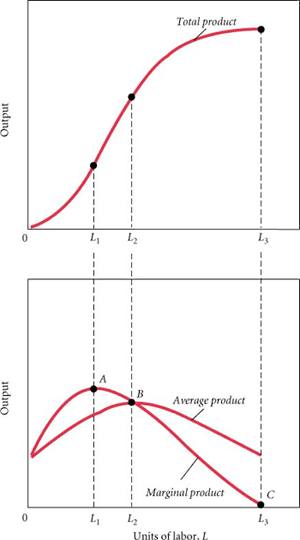
Product Function
This graph illustrates the way in which a production function identifies the relationship between a quantity of inputs and the resulting output of a given product. This takes into account marginal and average product, which are indicative of the change in efficiency based upon inputs.
Forms of the Production Function
There are a variety of ways to approach the measuring of productivity in the context of production functions:
- Functional Form: One way a production function can be illustrated is through the following equation
. In this circumstance ‘Q’ is the quantity of output while each ‘x’ is a factor input. - Linear Form: While this is generally not practical in practice, it is also possible to represent this in a linear mathematical fashion if parameters (a, b, c, and d below) are identified:
- Cobb-Douglas Production Function: One of the most useful frameworks, that allow for a technological relationship to be illustrated between the amount of two (or more) inputs is the Cobb-Douglas model. This is most often used to illustrate how physical capital and labor effect one another (see ). In the equation, ‘Y’ is total production while ‘L’ is labor, ‘K’ is capital, ‘A’ is total factor productivity and the alpha and beta are the elasticity of the two inputs.
- Leontief Production Function: The Leontief Production Function assumes a technologically pre-determined set of proportions for the factors of production (i.e. no ability to substitute between factors. This is specifically designed to capture minimums or limiting cases of production. The ‘z’s in the equation are inputs of specific goods while the a and b represent the technological determined constants and ‘q’ being the overall output:
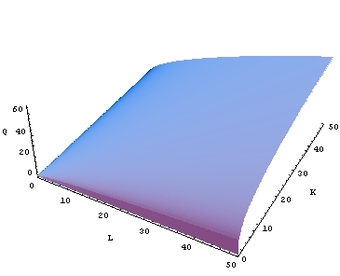
Cobb-Douglas Production Function
This is an illustration of a two-input Cobb-Douglas Production Function, where the ability to benchmark an output in comparison to two separate quantities of inputs is feasible.
20.3.3: Impacts of Technological Change on Productivity
Technological advances play a crucial role in improving productivity, and thus the standard of living in a system.
Learning Objective
Analyze how changes in technology affect productivity and productivity growth
Key Points
- Productivity growth is bound by what is called the production-possibility frontier (PPF), which essentially stipulates a series of maximum amounts of two commodities that can be generated using a fixed amount the relevant factors of production.
- The variance in technological advances that have driven productivity upwards is remarkable, underlining the ongoing importance of focusing on technology as a primary change agent.
- Advances in energy systems, transportation, communication, logistics, and a variety of other technological trajectories have greatly enabled an increased standard of living through advancing productivity.
- Measuring the affects of technology on productivity is a difficult pursuit. It is generally approached through metrics such as Gross Domestic Product (GDP), GDP per capita, and Total Factor Productivity (TFP).
Key Terms
- Production-Possibility Frontier (PPF)
-
A graph that shows the various combinations of amounts of two commodities that could be produced using the same fixed total amount of each of the factors of production.
- productivity
-
A ratio of production output to what is required to produce it (inputs).
Productivity measures the way in which an economic system or business can leverage available functional inputs to generate meaningful outputs. This concept drives economies towards higher degrees of efficiency in production and thus higher economic growth and standards of living. As a result, improving productivity is a critical objective for societies to increase their relative wealth. Technological advances play a crucial role in improving productivity, and thus the standard of living in a system.
Production-Possibility Frontier
Productivity growth is bound by what is called the production-possibility frontier (PPF), which essentially stipulates a series of maximum amounts of two commodities that can be generated using a fixed amount the relevant factors of production . In the context of a given PPF, only an increase in overall supply of inputs or a technological advancement will allow for the PPF to shift out and allow for an increase in potential outputs of both goods simultaneously (represented by point ‘X’ in the figure). The shift due to changes in technology represents increased productivity. This is a critical component in understanding the role of technology in productivity, as it is a primary influence on increasing the prospective production possibilities.

Production-Possibility Frontier (PPF)
This graph illustrates the varying theoretical takeaways from a PPF chart. On this, points B, C, and D all lie on a maximum output level, while A is representative of a realistic but inefficient amount. X is beyond the scope of the PPF graph, and thus requires a technological improvement or increase in supply.
Technological Advances: Past, Present, and Future
The variance in technological advances that have driven productivity upwards is remarkable, underlining the ongoing importance of focusing on technology as a primary change agent. Innovative advances in technologies can be either leaps or increments, although the larger technological advances tend to take the limelight. In general, there are a particularly notable categories:
- Energy: Historically, animals and humans were the primary energy input for the generation of products. This was extremely expensive and time-consuming relative to more modern ways to power things, and has been improved upon dramatically over time. Electricity, heat, steam, water, solar, and a wide variety of other energy capturing methodologies have dramatically increased efficiency while freeing up man hours.
- Transportation and Industrial Machinery: Trade has been a part of human history for nearly as long as civilizations knew of one another, bartering being the a central component of human interaction. The improvement of trade venues, such as boats, cars, planes, trains, etc. have enabled rapid increases in trade quantity and efficiency. Similarly, industrial machinery utilizing similar vehicles have enabled mass increases in scale and efficiency, particularly agriculture .
- Communication:Needless to say, the internet and mobile communications have rapidly expedited the transmission of knowledge, data, information, and networking. This has resulted in a massive increase in synergy across the world, alongside the development of economic learning and development.
- Logistics: Increases in technological systems is generally considered to be a tangible innovation, but is not limited to such. Improvements in the ways in which we do things is often just as useful. Henry Ford is a classic example of this, innovating the assembly line to maximize the efficiency the production process through strategic implementation of labor roles.
Implications on Productivity
Measuring the effects of technology on productivity is a difficult pursuit. It is generally approached through metrics such as Gross Domestic Product (GDP), GDP per capita, and Total Factor Productivity (TFP). The former two attempt to capture the overall output of a given economy from a macro-environmental perspective. The latter is slightly more interesting, attempting to measure technologically driven advancement through noting increases in overall output without increases in inputs. This is done through utilizing production function equations and identifying when the output is greater than the supposed input, implying an advance in the external technological environment. This system is more specifically tailored for technological change than GDP.
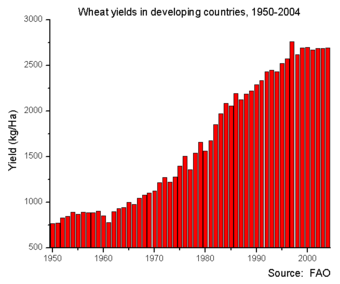
Wheat Yield
Over the past 60 years, wheat yield (PPF) has dramatically improved as a result of critical technological and logistic advancements.
20.4: Long-Run Growth
20.4.1: Determinants of Long-Run Growth
Long-run growth is defined as the sustained rise in the quantity of goods and services that an economy produces.
Learning Objective
Predict how population growth will affect the level of capital per worker
Key Points
- Economic growth is the increase in the market value of the goods and services that an economy produces over time. It is measured as the percentage rate change in the real gross domestic product (GDP).
- Determinants of long-run growth include growth of productivity, demographic changes, and labor force participation.
- When the economic growth matches the growth of money supply, an economy will continue to grow and thrive.
- Inflation occurs in an economy when the prices of goods and services continue to rise while the purchasing power decreases.
- When the GDP growth is only caused by increases in population, the growth is excessive.
Key Terms
- inflation
-
An increase in the general level of prices or in the cost of living.
- economic growth
-
The increase of the economic output of a country.
Long-Run Growth
Economic growth is the increase in the market value of the goods and services that an economy produces over time. It is measured as the percentage rate change in the real gross domestic product (GDP) .
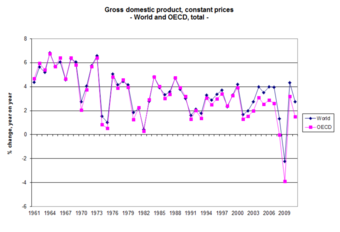
Measuring the GDP
Economic growth is the percentage rate increase in the GDP. Long-run growth is directly impacted by the GDP.
Long-run growth is defined as the sustained rise in the quantity of goods and services that an economy produces. The GDP of a country is closely tied to the growth of the population in addition to prices and supply and demand.
Determinants of Long-Run Growth
There are specific determinants that impact the long-run growth of an economy:
- Growth of productivity: is the ratio of economic outputs to inputs (capital, labor, energy, materials, and services). When the productivity increases the cost of goods is lowered. Lower prices increase the demand for the product or service. An increase in demand can lead to higher revenue.
- Demographic changes: demographic factors influence economic growth by changing the employment to population ratio. Factors include the quantity and quality of available natural resources. Age structure of the population also influences employment and long-run growth.
- Labor force participation: the amount of labor force participation and the size of economic sectors influence economic growth. The labor force participation is the amount of workers available. In countries with high development and industrialization, labor force participation is high because of low birth and death rates.
Inflation and Excessive Growth
When the economic growth matches the growth of money supply, an economy will continue to grow and thrive. In this case, population growth would increase, but the need for goods and services would also increase. As a result, more jobs would be available and the employment rate would also increase.
However, when economic growth is not balanced, the result can include inflation and excessive growth. Inflation occurs when the price of goods and services are rising which causes purchasing power to fall if wages don’t also rise . A decrease in the demand for goods and services will lead to a decrease in revenue and employment. A high rate of population growth will cause less capital per worker, lower productivity, and lower GDP growth.

Inflation
Inflation occurs when the price of goods and services are rising which causes purchasing power to fall if wages don’t also rise. Inflation is a negative effect of economic growth that is not balanced.
When the GDP growth is only caused by increases in population (not increases in supply, demand, revenue) the growth is excessive. In order for an economy to be successful, it must meet the needs of the population (supply, demand, revenue, and employment). When a population grows too fast the economic system cannot support the changes. Excessive growth leads to an imbalance in supply and demand and higher levels of unemployment. The quality of living decreases when the economy cannot support the population growth.
20.4.2: Aggregate Production
The aggregate production function examines how the productivity depends on the quantities of physical capital per worker and human capital per worker.
Learning Objective
Discuss how aggregate production impacts long-run growth
Key Points
- Aggregate production functions create an estimated framework to determine how much of an economies’ growth is related to changes in capital or changes in technology.
- The aggregate production function describes the boundary representing the limit of output attainable from each feasible combination of input.
- The aggregate production takes the physical outputs and inputs into account to determine the allocative efficiency of the economy as a whole.
- The long-run growth of a firm can change the scale of operations by adjusting the level of inputs that are fixed in the short-run, which shifts the production function upward as plotted against the variable input.
Key Terms
- physical capital
-
A physical factor of production (or input into the process of production), such as machinery, buildings, or computers.
- human capital
-
The stock of competencies, knowledge, social and personality attributes, including creativity, embodied in the ability to perform labor so as to produce economic value.
Aggregate Production
The aggregate production function examines how productivity, or real GDP per worker, depends on the quantities of physical capital per worker and human capital per worker. The production function relates the physical outputs of production to the physical inputs or factors of production. The aggregate production takes the physical outputs and inputs into account to determine the allocative efficiency of the economy as a whole.
Aggregate production functions create an estimated framework to determine how much of an economy’s growth is related to changes in capital or changes in technology. Production functions assume that the maximum output is attainable from a given set on inputs. The aggregate production function describes the boundary representing the limit of output attainable from each feasible combination of input.
To understand how the aggregate production impacts long-run growth, it is important to understand the stages of production :
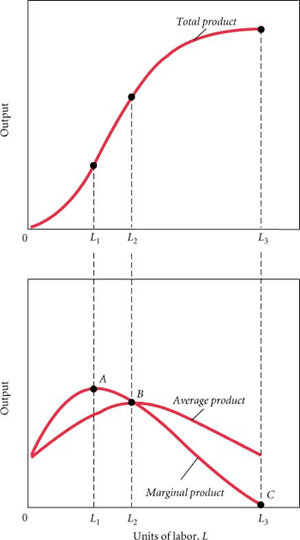
Graphing Production
The production function of a firm or economy can be graphed using the total, average, and marginal products. The aggregate production is determined based on the stages of production and the results of the graph.
- Stage 1: the variable input is being used with increasing output per unit. The average physical product is at its maximum.
- Stage 2: output increases at a decreasing rate and the average and marginal physical product are declining. The average product of fixed inputs are still rising. The optimum input/output combination will be reached.
- Stage 3: variable input is too high relative to the available fixed inputs. The output of both fixed and variable input declines.
Aggregate Production and Long-Run Growth
The long-run growth of a firm can change the scale of operations by adjusting the level of inputs that are fixed in the short-run, which shifts the production function upward as plotted against the variable input. Aggregate production functions study the short-run inputs and outputs of a firm or economy. The results allow adjustments to be made which improves the long-run growth by balancing the inputs and outputs.
20.4.3: Changing Worker Productivity
In economics and long-run growth, worker productivity is influenced directly by fixed capital, human capital, physical capital, and technology.
Learning Objective
Examine the role of human capital in production and economic growth
Key Points
- Human capital is defined as the stock of competencies, skills, and knowledge that allows individuals to produce economic value.
- Human capital has been show to increase economic development, productivity growth, and innovation.
- When individuals and societies invest in human capital it strengthens the future of the long-run economic growth. The qualitative and quantitative progress of a country is inevitable when human development is a priority.
- When a society invests in human capital, it increases worker productivity and economic growth. Human capital grows cumulatively over a long period of time.
Key Terms
- human capital
-
The stock of competencies, knowledge, social and personality attributes, including creativity, embodied in the ability to perform labor so as to produce economic value.
- productivity
-
A ratio of production output to what is required to produce it (inputs).
Worker Productivity
In economics and long-run growth, worker productivity is influenced directly by fixed capital. The four types of fixed capital include: useful machines, instruments of the trade; buildings as the means of procuring revenue; improvements of land; and the acquired and useful abilities of all the inhabitants or members of society.
One way to increase worker productivity is to invest in better machinery, for example. A worker with a more productive tool in more productive.
Another way to increase productivity is to find ways to increase the revenue of the product generated by the workers. Since productivity is measured in dollars per worker, being able to generate more revenue from the same output is reflected in an increase in worker productivity.
Perhaps most interesting, though, is how to change worker productivity through human capital.
Human Capital
Human capital is defined as the stock of competencies, knowledge, social and personal attributes, including creativity, embodied in the ability to perform labor so as to produce economic value. Many economic theories tie education to economic growth explaining that it is an investment in human capital development . Human capital has been shown to increase economic development, productivity growth, and innovation.
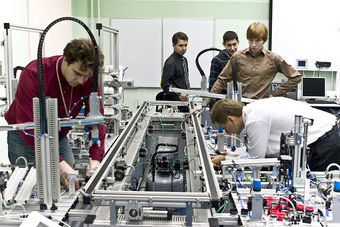
Education
Education increases human capital and worker productivity.
A human resource is transformed into human capital with the effective inputs of education, health, and moral values. When individuals and societies invest in human capital it strengthens the future of the long-run economic growth. The qualitative and quantitative progress of a country is inevitable when human development is a priority. Over time, when worker productivity increases the quality and quantity of the goods and services will also increase.
Importance of Worker Productivity
When a society invests in human capital, it increases worker productivity and economic growth. Human capital and increased worker productivity are critical because they are different from the tangible monetary capital or revenue. It is important thought that an economy recognizes the importance of monetary capital. Worker productivity in the long-run is related to real income. If the real income falls over time it will negatively impact worker productivity. Economic revenue goes up and down due to shocks in the business cycle. Human capital grows cumulatively over a long period of time. When a society focuses on human capital and in turn worker productivity, the long-run economic growth will be steady. Economic inputs towards education, health, and worker productivity impacts future generations by ensuring that they will be more advanced and efficient than the current generation. The increase in worker efficiency is the direct result of a superior quality of manpower created through increased human capital.
20.4.4: Technological Change
In economics, technological change is a term used to describe the change in a set of feasible production possibilities.
Learning Objective
Assess the value of technology to a nation’s economic growth
Key Points
- Growth is defined as the increase in output per capita of a country over a long period of time. One primary factor that influences the growth of an economy is technological change.
- When looking at long-run growth, technological change in the economic environment makes production more or less efficient.
- Technology is defined as the making, modification, usage, and knowledge of tools, machines, techniques, systems, and methods of organization in order to solve a problem, improve a preexisting solution to a problem, or achieve a goal.
- The expansion and sharing of technology leads to the further development of goods, processes, applications, materials, and services. All of these areas are critical to the advancement of an economy in the long-run.
- The expansion and sharing of technology leads to the further development of goods, processes, applications, materials, and services. All of these areas are critical to the advancement of an economy in the long-run.
Key Terms
- technology
-
The study of or a collection of techniques.
- output
-
Production; quantity produced, created, or completed.
Technological Change
In economics, growth is defined as the increase in output per capita of a country over a long period of time. One primary factor that influences the growth of an economy is technological change. Technological change is a term used to describe the change in a set of feasible production possibilities. Technological improvement has the ability to increase the amount of output an economy can produce, even if the level of inputs remains constant .

Technological Change
Technological change causes the production possibility frontier to shift outward and initiate economic growth.
Technology and Long-Run Growth
Technology is defined as the making, modification, usage, and knowledge of tools, machines, techniques, systems, and methods of organization in order to solve a problem, improve a preexisting solution to a problem, or achieve a goal . In economics, improvements in technology have helped develop more advanced economies (for example, today’s global economy).
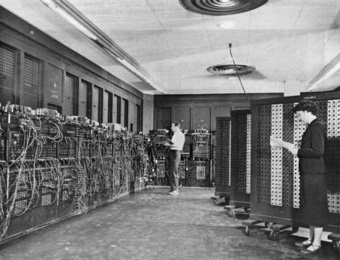
ENIAC
ENIAC, the first general purpose computer, was a technological advancement that affected both productivity and the types of outputs that could be produced.
In a developing country, the government works to ensure that the technologies, skills, knowledge, and methods of manufacturing are tested and developed so that they can be passed on to a broader audience. The expansion and sharing of technology leads to the further development of goods, processes, applications, materials, and services. All of these areas are critical to the advancement of an economy in the long-run.
The field of economics is constantly evolving as is the production of goods and services. In order to advance and continue to grow all markets need to make use of new technology to stay competitive. In the case of long-run economic growth, using the most advanced technology provides a market with a competitive advantage. Advances in technology creates an increased level of output with the same inputs, which improves productivity.
20.4.5: Government Activity
Government activity and policies have a direct impact on long-run growth. It can invest, and operate through monetary and fiscal policy.
Learning Objective
Discuss the long-run implications on growth from government policies
Key Points
- Long-run growth is the increase in the market value of goods and services produced by an economy over a period of time.
- The government may choose to invest in projects that are associated with long-term growth, such as infrastructure.
- Monetary and fiscal policy are used to regulate the economy, economic growth, and inflation so that long-run growth is possible.
- Government activities used to improve long-run growth include stimulating economic growth, enacting monetary policies, fixing the exchange rates, and using wage and price controls.
Key Terms
- economic growth
-
The increase of the economic output of a country.
- monetary policy
-
The process by which the central bank, or monetary authority manages the supply of money, or trading in foreign exchange markets.
Economic Growth
In macroeconomics, long-run growth is the increase in the market value of goods and services produced by an economy over a period of time. The long-run growth is determined by percentage of change in the real gross domestic product (GDP) . In order for an economy to experience positive long-run growth its outputs and inputs must be in balance for an increase to occur in supply, demand, revenue, and employment. The long-run economic growth is determined by short-run economic decisions.
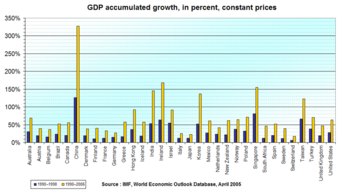
Gross Domestic Product
The change in GDP is used to determine economic growth within a country.
Government Activity
Government activity and policies have a direct impact on long-run growth. Long-run growth can be redirected and improved when changes are made to short-run actions. When an economy or industry experiences imbalanced in economic growth, the government can respond in order to assist in securing the market. Examples of possible government activity include:
- Investment: the government can stimulate economic growth by investing in the economy. Examples of stimulants include investing in market production, infrastructure, education, and preventative health care. This is especially important when excessive growth occurs. The government must stimulate economic growth to meet the needs of an increasing population.
- Monetary policy: the government enacts monetary policies to keep the growth rate of money steady. This helps to control excess inflation and excess short-term growth, both of which can negatively affect long-run growth. It’s important to note, however, that fiscal policy can also affect the level of inflation within an economy.
- Fiscal Policy: Choices in tax structure, government spending, and economic regulation can all impact long-run growth by affecting the choices that businesses and individuals make.
Government activity impacts long-run growth. It is critical that increasing populations have access to productive resources. It is also important that markets stay balanced in order to be successful and thrive.
20.4.6: Arguments in Favor and Opposed to Economic Growth
Economic growth has the potential to make all people richer, but may have downsides such as increased inequality and environmental impacts.
Learning Objective
Compare and contrast the consequences of economies in which growth is a goal
Key Points
- Over the long-run economic growth looks at the growth of the ratio of GDP to the population. Economic growth is an expansion of the economic output of a country.
- Arguments in support of economic growth include increased productivity, the expansion of power, and an increase in the quality of life.
- Arguments opposed to economic growth include resource depletion, environmental impacts, and equitable growth.
Key Terms
- quality of life
-
The general well-being of societies, including not only wealth and employment, but also the environment, physical and mental health, education, recreation and leisure time, and social belonging.
- economic growth
-
The increase of the economic output of a country.
Economic Growth
Economic growth is defined as the increase in the market value of goods and services produced by an economy over a period of time. It is measured as the percentage increase in the real gross domestic product (GDP) . In other words, economic growth is an expansion of the economic output of a country. Over the long-run economists might look at the per-capita rate of GDP growth (the growth of the ratio of GDP to the population).

GDP
The percentage increase in the GDP of a country is used to measure the country’s economic growth.
Arguments in Favor of Growth
There are numerous arguments in support of economic growth that describe its positive impact on society. Arguments in favor of economic growth include:
- Increased productivity: in countries that experience positive economic growth, the growth is often attributed to an increase in human and physical capital. Also, economic growth is usually accompanied by new and improved technological innovations.
- Expansion of power: economic growth is influential within a country even if the percentage of growth is small. With a small growth rate, a country will experience a substantial increase in power over the long-run. For example, a growth rate of 2.5% per annum leads to a doubling of the GDP within 29 years. In contrast, a growth rate of 8% per annum leads to a doubling of the GDP within 10 years. The power expansion associated with economic growth has long-run influences on a country.
- Quality of life: the quality of life increases in countries that experience economic growth. Economic growth alleviates poverty by increasing employment opportunities and labor productivity. It has been found that happiness increases with a higher GDP per capita, up to a level of at least $15,000 per person.
Arguments Opposed to Growth
There are a series of arguments that are opposed to economic growth. Arguments opposed to growth include:
- Resource depletion: economic growth has the potential to deplete resources if science and technology do not produce viable substitutes or new resources. Also, some arguments state that better technology and more efficient production will deplete resources quicker in the long-run even though advancements are perceived as positive right now.
- Environmental impact: some argue that a narrow view of economic growth combined with globalization could collapse the world’s natural resources. Portions of society have advocated the ideas of uneconomic growth and de-growth (economic contraction) in an attempt to lessen these effects of economic growth.
- Equitable growth: it has been found that while economic growth has a positive impact on society as a whole, it is common that poor sections of society are not able to participate in economic growth. Economic growth has many positive effects, but a society must not favor economic growth over solving pressing social issues such as poverty. For example, in a country with low inequality, a country with a growth rate of 2% per head and 40% of the population living in poverty can halve the poverty in 10 years. In contrast, if the same country has high inequality it will take nearly 60 years to achieve the same level of poverty reduction.
20.5: The Impact of Policy on Growth
20.5.1: Incentivizing Saving and Investment
The government can incentivize savings and investment by changing the relative cost of taking each action.
Learning Objective
Explain how the governments incentivize saving and investment
Key Points
- Monetary policy seeks to encourage investment by lowering interest rates and to encourage savings by borrowing them.
- Governments give tax breaks to industries in which it wants to encourage investment.
- Governments can also make certain types of savings tax exempt if it wishes to encourage savings.
Key Term
- monetary policy
-
The process of controlling the supply of money in an economy, often conducted by central banks.
Governments have a strong interest in affecting the savings and investments in an economy. Both savings and investment affect the overall economy. For example, if an economy is overheating, a government might want to disincentivize investment or consumption, and would therefore be interested in increasing the savings rate. If an economy is in a recession, a government would want to encourage savers to start spending or investing their money .
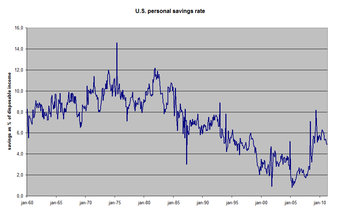
US Savings Rate
The US government may want to increase the savings rate if the economy is in a downturn, and increase it if the economy is overheating.
There are a number of ways in through which a government can incentivize savings and investment. Broadly, each incentive adjusts the cost of saving or investing. We will discuss two main ways to affect the savings and investment rates here.
Monetary Policy
One of the main tools of central banks is the interest rate that it charges banks to hold their money overnight. This rate is ultimately passed on to the bank’s depositors. Depositors, in turn, adjust their levels of savings and investment based on that rate.
Take, for example, a high interest rate. At a high interest rate, it is very expensive to borrow money: investors will not want to invest because they have to pay a lot of interest on their loans. Savers, on the other hand, love high interest rates: they earn a lot simply by keeping their cash in the bank. High interest rates encourage savings and discourage investment.
The precise opposite is true for low interest rates. When rates are low, investors know they can borrow money to finance investments cheaply. At the same time, savers aren’t earning much by keeping their money in the bank. Low interest rates encourage investment and discourage savings.
Much of a central bank’s actions are focused on adjusting how much people save and invest.
Taxes
The government can also incentivize savings and investment in a number of ways. The most common way of doing so is by adjusting tax rates. Governments offer individuals and firms who take the action it desires. For example, a government can offer a tax break to companies that are investing in a desirable area (e.g. medicine). It can also encourage savings through tax breaks. Roth IRAs are an instrument for saving for retirement that the US has made tax exempt (under certain conditions). In the first example, the government uses tax reductions to encourage investment for companies. In the second, the government encourages saving by helping savers earn more of the interest they earn over time in the savings vehicle.
20.5.2: Improving Education and Health Outcomes
A country can impact its long-term growth by affecting human capital through education and healthcare investments.
Learning Objective
Analyze the long-run implications on growth from education and healthcare policies
Key Points
- Both education and healthcare systems have short- and long-term costs, but can also be viewed as investments in human capital.
- Education economics studies the relationship between schooling and the labor market.
- Health economics is the branch of economics that focuses on issues relating to the efficiency, effectiveness, value, and behavior in the production and consumption of health and healthcare.
- According to the World Health Organization, a successful health policy defines a vision for the future, it outlines national priorities regarding health, and it builds a consensus and informs the public.
Key Terms
- economic growth
-
The increase of the economic output of a country.
- human capital
-
The stock of competencies, knowledge, social and personality attributes, including creativity, embodied in the ability to perform labor so as to produce economic value.
Both education and healthcare are important because they have short- and long-term costs, and significantly affect the level of human capital in an economy. If a country can set up its education and healthcare systems to maximize the growth of human capital, it can also significantly impact its long-term economic growth prospects.
Education Economics and Policies
Education economics studies economic issues related to education, such as the demand for education and the financial cost of education. It studies the relationship between schooling and the labor market. By making educational policies and spending money now, a country ensures that it will have the necessary human capital to expand its economy.
Human capital requires investment, but also provides economic returns. As education increases human capital increases, countries will also expect to see higher productivity, wages, and the GDP .
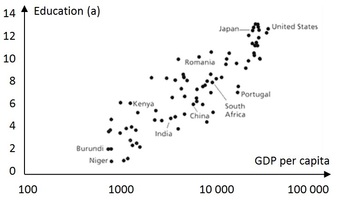
Impact of Education on GDP
This graph shows the positive relationship between education and per capita GDP of a country. As the number of years of education within a country increase, so does the per capita GDP.
Economics is one field of study that researches the effectiveness of education policies. Education policies are designed to cover all education fields from early childhood education through college graduate programs. Policies focus on school size, class size, school choice, tracking, teacher education and certification, teacher pay, teaching methods, curricular content, and graduation requirements. To ensure economic growth, a country must have strong education policies.
Health Economics and Policies
Health economics is the branch of economics that focuses on issues relating to the efficiency, effectiveness, value, and behavior in the production and consumption of health and healthcare. In this field, economists study the function of healthcare systems and public health-affecting behaviors. Health economics focuses on the following topics:
- What influences health
- What is health and what is its value
- What is the demand for healthcare
- What is the supply for healthcare
- Macro-economic evaluation at treatment level
- Market equilibrium
- Evaluation of the whole healthcare system
- Planning, budgeting, and monitoring the system
Although health is not directly related to human capital, it is obvious that without health and life human capital will be impacted negatively. Health policies are the decisions, plans, and actions that are undertaken in a country to achieve specific healthcare goals. According to the World Health Organization, a successful health policy defines a vision for the future, it outlines national priorities regarding health, and it builds a consensus and informs the public.
Health policies can have positive long-run effects on not only human capital, but also economic growth as a whole. Health policies are designed to educate society and improve the current and long-term health of a country. Examples of health policy topics include: vaccination policies, tobacco control, and pharmaceutical policies.
Furthermore, healthcare can constitute a large part of a country’s expenditures. Determining the structure of the healthcare system (private, public, regulated, etc.) can have large economic consequences, and therefore is of great interest to the government.
20.5.3: Defining and Defending Property Rights
Property rights are theoretical constructs that determine how a resource is used and owned.
Learning Objective
Explain the economic consequences of property rights
Key Points
- There are four broad components that property rights consist of: the right to use the good, the right to earn income from the good, the right to transfer the good to others, and the right to enforcement of property rights.
- Property usually refers to ownership and control over a good or resource. Ownership means that the entity or individual has the rights to the proceeds of the output that the property generates.
- There are four types of property rights: open access, state, common, and private.
Key Terms
- resource
-
Something that one uses to achieve an objective, e.g. raw materials or personnel.
- property rights
-
The exclusive rights pertaining to the ownership of a given asset.
Property Rights
Property rights are theoretical constructs that determine how a resource is used and owned. Resources can be owned and used by governments, collective bodies, or individuals. There are four broad components of property rights. They are the right to:
- use the good,
- earn income from the good,
- transfer the good to others, and
- enforce the property rights.
Property usually refers to ownership and control over a good or resource. Ownership means that the entity or individual has the rights to the proceeds of the output that the property generates.
Types of Property Rights
Property rights are determined based on the level of transaction costs associated with the rights. The transaction costs are the costs of defining, monitoring, and enforcing the property rights. The four types of property rights are:
- Open access property: this type of property is not owned by anyone. For this reason, no one can exclude anyone else from using it. It is possible though that one’s person use of the property will reduce the quantity available to others. Open access property is not managed by anyone and access to it is not controlled. Examples include the atmosphere or ocean fisheries.
- State property: also known as public property, this type of property is owned by all, but its access and use is controlled by the state. An example would be a national park .
- Common property: also called collective property, this type of property is owned by a group of individuals. The joint owners control the access, use, and exclusion of the property.
- Private property: use of this type of property is exclude. Private property use and access is managed and controlled by a private owner or a legal group of owners.
Defending Property Rights
For any good, property rights must be monitored and the possession of the rights must be enforced. The rights are put in place to control, monitor, and exclude the use of the stated property. Property rights protect not only land, but also goods, services, and finances associated with the land itself. Corruption impacts the private and public sectors because it increases the cost of doing business and distorts markets.
The concept of property rights are closely related to the law in terms of defending the rights. There is a difference between an economist’s view of property rights and the view of the law, but both work together to reach the final goal of securing and maintaining the rights. For example, suppose a thief steals a good. The thief has economic property right to the good because it is in his possession – he has the ability to use the good. However, the thief does not have legal property right to use the good – by law he is not permitted to have access to or use of the good. Economics sets the property rights and the law is used to enforce the rights. Each of the four types of property rights differ in the amount of money and defense needed to ensure that the rights are upheld. The greater the restrictions that property rights place, the more likely that defense of the rights will be needed.

Yosemite National Park
This picture is a view at Yosemite National Park. National parks in the United States are state property. Access and use of the park is controlled and enforced by the state.
20.5.4: Promoting Free Trade
Government can promote free trade by reducing tariffs, quotas, and non-tariff barriers.
Learning Objective
Describe the effects of free trade and trade barriers on long run growth
Key Points
- Free trade allows countries to produce the good in which they have a comparative advantage, which increases overall welfare.
- Tariffs and quotas are explicit government economic protections that reduce the efficiency of global markets.
- Non-tariff barriers like quality standards and customs paperwork are other government-implemented barriers to trade.
- Governments can reduce barriers to free trade unilaterally, bilaterally, or multilaterally.
Key Terms
- tariff
-
A system of government-imposed duties levied on imported or exported goods; a list of such duties, or the duties themselves.
- comparative advantage
-
The ability of a party to produce a particular good or service at a lower margin and opportunity cost over another.
Free trade is a policy by which a government does not discriminate against imports or interfere with exports by applying tariffs (to imports), subsidies (to exports), or quotas. According to the law of comparative advantage, the policy permits trading partners mutual gains from trade of goods and services.
Government Barriers to Free Trade
There are a number of barriers to free trade that governments can mitigate, most importantly, tariffs (government imposed import taxes) and quotas (government imposed limits on the quantity of a good that can be imported). Tariffs and quotas are explicit government policies that are designed to protect domestic producers, even if they are not the most efficient producers .

Loss Due to Tariffs
There are a number of reasons why governments place tariffs or other barriers to free trade, but they necessarily reduce overall societal welfare. Governments can promote free trade and impact economic growth.
In addition to tariffs and quotas, there are a number of other barriers to free trade that countries use. Broadly, they are categorized as non-tariff barriers (NTBs). NTBs come in a variety of forms. One example of an NTB are product standard requirements. A country can set high quality standards for a product, knowing that not all foreign producers will be able to meet the standard. Another way that countries can implement NTBs is through customs procedures. Countries can force foreign exporters to fill out arduous paperwork over the course of months, and perhaps in a language the foreign producer does not speak. NTBs act just like tariffs and quotas in that they are barriers to free trade.
Government Promotion of Free Trade
Countries that recognize the benefits for growth from promoting free trade can take unilateral, bilateral, or multilateral action to reduce some of these barriers to trade.
Unilateral promotion of free trade is when a country decides to reduce its own trade barriers without any promise of action from its trading partners. This would lead to a reduction in import prices, but could be unpopular with domestic industries who are not afforded lower barriers in the countries with which they wish to trade.
Bilateral promotion of free trade is when two countries come to an agreement to reduce barriers together. This solves the problem of one country giving the benefit of reduced barriers to foreign exporters without any promise of similar benefits in return.
Multilateral promotion of free trade is when a group of countries agree to reduce their barriers together. Examples of multilateral promotion of free trade are trade agreements such as the North American Free Trade Agreement (NAFTA) in which the US, Mexico, and Canada agreed to allow free trade among one another.
Reducing barriers to free trade may be politically difficult, but due to the law of comparative advantage, will allow for increased overall surplus for each trading partner in the long run.
20.5.5: Investing in Research and Development
The government can establish intellectual property laws, directly conduct research, or finance research and development.
Learning Objective
Describe the appropriate role of government in research and development
Key Points
- Patents are a form of intellectual property rights protection that encourages researchers to invest in research.
- The government can conduct research itself. NASA is an example of a government agency that conducts research and development directly.
- The government offers funding to non-government researchers, often through grants.
Key Terms
- intellectual property
-
Any product of someone’s knowledge that has commercial value: copyrights, patents, trademarks and trade secrets.
- research and development
-
The process of discovering and creating new knowledge about scientific and technological topics in order to develop new products
The government has the ability to encourage or discourage research and development. The government can do so by creating a good structure of intellectual property protection, called, broadly, patent law. It can also directly intervene and encourage or discourage research and development in a specific area of interest to the government or society that is not currently being addressed by the market.
Investing in research and development is important because it can result in new products, technologies, or processes. Thus, research and development can improve productivity or simply improve the welfare of society.
This atom will first discuss how the government can establish a patent system, and then ways in which it can directly affect the level of research and development in an economy.
Patents
Patents are temporary monopolies granted to inventors by the government, in exchange for public disclosure of how the invention works. They are one of the basic forms of intellectual property. Essentially, a patent gives the holder the right to exclude others from, among other things, using, selling, and making the claimed invention.
Patents and, more broadly, intellectual property rights, are important because they encourage investment in research. Without intellectual property protection, researchers would be worried that, once they make a breakthrough, competitors would simply sell their product. The original researcher would have made the investment in the research, but would have to compete with others once the research becomes able to generate revenue.
Direct Government Research
When the government directly conducts research, it hires its own scientists, engineers, etc. to study a particular issue. For example, NASA is a government agency that also does research.
Indirect Government Research
The government also finances research and development that it does not directly conduct. Such financing often takes the form of grants given to researchers in companies or organizations by the government. The government incentivizes the researches by making the research financially affordable (or more affordable). Not all research is financed, however. The grants are given to projects that are valuable either to the government or to society as a whole. Such grants can be viewed through the lens of market failure: the open market is not financing a socially or government-desirable project, so the government steps in to correct the failure.

NASA’s Research and Development
The moon landing was the result of research and development conducted directly by a government agency.
